Resources

What Is Rockwool Insulation? Rockwool insulation, also known as mineral wool or stone wool, is a highly effective and versatile insulation material widely used in Ireland for residential and commercial properties. It is manufactured by heating natural stones like basalt at extreme temperatures until molten, which is then spun into fibres resembling wool. This process creates a dense, durable material that offers excellent thermal, acoustic, and fire-resistant properties. Rockwool is available in various forms, such as rolls, batts, and rigid boards, making it suitable for walls, floors, ceilings, and cavity insulation. It’s particularly favoured for its sustainable properties, as it is often made from up to 70% recycled materials. Why Choose Rockwool Insulation for Your Irish Home? Superior Thermal Performance Rockwool insulation boasts an impressive R-value, meaning it offers superior thermal resistance compared to other insulation types like fibreglass. This high R-value helps retain heat during colder months and keeps homes cool during summer, making it ideal for Ireland’s fluctuating climate. Acoustic Soundproofing The density of Rockwool makes it an excellent soundproofing material, reducing noise between rooms or from external sources. This makes it a popular choice for urban homes or properties near busy roads. Benefits of Rockwool Insulation Fire Resistance: Can withstand temperatures up to 1,400°F (760°C). Moisture Resistant: Does not absorb water, preventing mould growth. Eco-Friendly: Made from recycled materials and is sustainable. Key Applications of Rockwool Insulation Loft and Attic Insulation Rockwool insulation is perfect for attics and lofts, where it can be installed between rafters to improve thermal efficiency. Its ability to resist moisture ensures that it performs well in areas prone to condensation. Wall Insulation Rockwool batts and boards are ideal for cavity and solid wall insulation. The material’s fire resistance and durability make it a reliable choice for new builds and retrofits. Additional Benefits of Rockwool Durability: Retains its shape and performance for decades. Ease of Installation: Simple to cut and install with minimal irritation compared to fibreglass. Improved Energy Efficiency: Reduces heating costs, contributing to lower energy bills. Why Rockwool Insulation is a Smart Choice in Ireland Ireland’s diverse climate calls for insulation materials that are robust, versatile, and sustainable. Rockwool’s ability to provide excellent thermal and acoustic performance, coupled with its eco-friendly properties, makes it a preferred choice for many Irish homeowners and builders. Its resistance to fire, moisture, and mould adds further value, ensuring your property remains safe and energy-efficient for years to come. For more information on how Rockwool can transform your home, visit our Contact Page .

Discover how spray foam insulation can enhance your home’s value, improve energy efficiency, and appeal to potential buyers in Ireland’s property market. In Ireland’s competitive property market, homeowners and landlords are always looking for ways to increase the value of their properties while making them more comfortable and energy-efficient. One of the most cost-effective and high-impact ways to achieve this is by installing spray foam insulation. Not only does spray foam improve the energy efficiency of your home, but it can also make your property more attractive to potential buyers, increase its overall value, and lead to long-term savings on utility bills. In this blog, we’ll explore how spray foam insulation can boost your property’s market value and why it’s a smart investment for homeowners in Ireland. What is Spray Foam Insulation? Spray foam insulation is a modern solution for improving the thermal efficiency of a property. It is made from two components—polyurethane foam and isocyanate—that react when mixed, forming a highly effective insulating material. This foam expands upon application, filling gaps, cracks, and cavities, creating an airtight seal that prevents heat from escaping in winter and cool air from escaping in summer. Spray foam insulation is particularly effective in hard-to-reach areas, such as attics, walls, floors, and even basements, where traditional insulation materials may not provide the same level of coverage or performance. How Spray Foam Insulation Increases Property Value Enhanced Energy Efficiency : In today’s market, energy efficiency is one of the key considerations for homebuyers. With energy bills continually on the rise, buyers are looking for homes that offer long-term savings. Spray foam insulation significantly improves a property’s energy efficiency by reducing heat loss and preventing drafts, leading to lower heating and cooling costs. Homes that are well-insulated with spray foam are more attractive to potential buyers who are looking for a sustainable, cost-effective home. The energy savings that come with spray foam can be a major selling point, especially as the Irish government continues to encourage energy-efficient homes. Better Thermal Comfort : Spray foam insulation helps to maintain consistent indoor temperatures throughout the year. In Ireland’s climate, where temperatures can vary widely, having a home that stays warm in winter and cool in summer adds to the comfort and livability of the space. This added comfort is a major selling point for prospective buyers, especially those with young children or elderly family members. The even temperature distribution helps to eliminate cold spots and dampness, which can be a concern in older homes. This means your property will not only be more comfortable for you while you live there but will also appeal to buyers seeking a comfortable living environment. Increased Property Appeal : Homes with spray foam insulation are often seen as modern and well-maintained. Buyers are increasingly aware of the benefits of energy-efficient homes, so properties that are already insulated with high-quality materials like spray foam tend to stand out in the market. Installing spray foam insulation can set your property apart from others, giving you an edge in a competitive market. Whether you’re selling a family home or a rental property, energy efficiency is a key factor that many buyers are willing to pay a premium for. Improved Soundproofing : Another benefit of spray foam insulation is its ability to improve soundproofing. Spray foam’s dense, airtight structure helps reduce noise transmission between rooms and from outside the property. This makes the home quieter and more peaceful, which is especially desirable in noisy urban areas or for properties near busy roads. A quieter home is always a bonus for buyers, as it contributes to a more comfortable living environment. Spray foam insulation can help create a space that feels more private and secluded, adding to its overall appeal. Long-Term Durability : Spray foam insulation is known for its long-lasting performance. Unlike traditional insulation materials, which may settle or deteriorate over time, spray foam remains intact and effective for decades. It won’t sag, shrink, or lose its insulating properties, providing lasting benefits to both homeowners and future buyers. Homes with long-term, low-maintenance features like spray foam insulation are more attractive to potential buyers who prefer properties that won’t require costly updates or repairs in the near future. The Return on Investment (ROI) of Spray Foam Insulation When you invest in spray foam insulation, you’re not just improving your home’s comfort and energy efficiency—you’re also making a smart financial decision. The cost of spray foam insulation can be recouped over time through lower energy bills, but it also increases the resale value of your property. Homes with energy-efficient features like spray foam insulation tend to sell faster and for a higher price than those without. In fact, a study by the U.S. Department of Energy found that homebuyers are often willing to pay more for homes with energy-efficient features, with some buyers willing to pay an additional 2-3% more for a property with superior insulation. In Ireland, where energy efficiency is becoming increasingly important to both homeowners and buyers, investing in spray foam insulation is a proactive way to increase your property’s value. Whether you're looking to sell now or in the future, spray foam insulation will continue to offer value long after it’s installed. Environmental Benefits That Appeal to Buyers Another growing trend in property sales is the focus on sustainability and environmental impact. Buyers are becoming more conscious of the carbon footprint of their homes, and many are prioritising energy-efficient properties that contribute to a greener future. Spray foam insulation plays a key role in reducing your home’s carbon emissions by cutting down on the energy required to heat and cool the property. By upgrading your home with spray foam insulation, you’re not only increasing its value and energy efficiency—you’re also contributing to a more sustainable future, which may appeal to eco-conscious buyers. Conclusion: Make the Smart Investment with Spray Foam Insulation Spray foam insulation offers a range of benefits that can increase your property value, from improving energy efficiency and reducing heating costs to enhancing comfort and soundproofing. Whether you’re planning to sell your home or want to make your current living space more comfortable, spray foam insulation is a smart investment that delivers long-term value. By installing spray foam insulation, you’re not only creating a more energy-efficient and comfortable home, but you’re also positioning your property as an attractive and modern choice for potential buyers in Ireland’s competitive property market. Take advantage of the benefits of spray foam insulation and enjoy a higher property value, reduced utility bills, and a more sustainable living space for years to come.

Learn how SEAI’s spray foam insulation grants can help you save on insulation costs, reduce energy bills, and make your home more comfortable. Insulating your home is one of the most effective ways to increase energy efficiency, reduce utility bills, and enhance comfort. To make insulation more accessible for homeowners, the Sustainable Energy Authority of Ireland (SEAI) offers grants that significantly offset the cost of insulation upgrades, including spray foam insulation. These grants are part of Ireland’s commitment to achieving a more sustainable, energy-efficient future by helping homeowners and landlords insulate their properties affordably. In this post, we’ll explore how SEAI spray foam insulation grants work, who is eligible, and how spray foam can benefit your home. Why Choose Spray Foam Insulation? Spray foam insulation is a high-performance solution known for its ability to create an airtight seal, filling all gaps, cracks, and hard-to-reach spaces. This results in excellent thermal efficiency, which helps your home stay warm in the winter and cool in the summer. By installing spray foam insulation, you can reduce your heating and cooling needs, leading to lower energy bills and a smaller environmental footprint. Spray foam insulation is especially beneficial for areas like: Attics : Prevents heat loss through the roof, the main source of energy loss in many homes. Walls : Eliminates drafts and provides a high level of insulation, even in tight spaces. Floors and Basements : Keeps cold air from rising into living spaces, improving comfort year-round. What is the SEAI Insulation Grant? The SEAI insulation grant is a government-backed initiative aimed at helping Irish homeowners reduce their energy consumption and costs by improving their property’s insulation. This grant covers a range of insulation types, including attic insulation, wall insulation, and spray foam insulation, allowing you to choose the best option for your home’s needs. By taking advantage of SEAI insulation grants, you can: Lower your insulation costs : Receive financial support that can cover a significant portion of the installation cost. Reduce your energy bills : Enjoy greater savings by reducing your heating and cooling needs. Increase comfort : Benefit from a warmer, more comfortable home, especially during colder months. Enhance property value : Energy-efficient upgrades can increase your home’s market value. Eligibility for SEAI Insulation Grants To qualify for the SEAI insulation grant, applicants need to meet specific eligibility criteria, which include: Property type : Grants are available for homeowners, landlords, and Approved Housing Bodies in Ireland. Residency : The property must be located in Ireland and must meet certain minimum insulation requirements. Age of the property : The grant typically applies to homes built and occupied before 2011, as these are more likely to benefit from energy-efficiency upgrades. Additional criteria and requirements may apply, so it’s advisable to check the SEAI website or consult with an approved SEAI contractor for the most up-to-date information. Benefits of SEAI Spray Foam Insulation Grants Financial Assistance : The SEAI insulation grant significantly lowers your out-of-pocket expenses, making high-quality insulation, such as spray foam, more affordable. By receiving a grant, you can invest in better insulation and reap the long-term benefits of reduced energy bills. Enhanced Comfort and Energy Efficiency : Spray foam insulation provides a high level of thermal efficiency, allowing your home to retain heat more effectively. This reduces drafts and cold spots, keeping your indoor spaces consistently comfortable, even during harsh winters. Environmental Impact : By installing spray foam insulation, you reduce your household's energy consumption, which lowers your carbon footprint. This is a small but essential step towards a more sustainable and environmentally-friendly home. Increased Property Value : Insulated homes are more attractive on the property market, as they offer potential buyers the promise of lower energy bills and enhanced comfort. By upgrading with spray foam insulation through SEAI grants, you’re investing in the long-term value of your property. How to Apply for the SEAI Spray Foam Insulation Grant Check Eligibility : Review the SEAI eligibility criteria to ensure you qualify for the insulation grant. Select an SEAI Registered Contractor : Only registered SEAI contractors can carry out work that qualifies for the grant. Choosing an experienced, qualified professional ensures the insulation meets SEAI standards and maximises your energy savings. Apply Online : Complete the SEAI grant application on their website. After approval, you’ll receive a grant offer, and you can begin scheduling your insulation upgrade. Schedule Installation : Work with your contractor to schedule your spray foam insulation installation. Once the work is completed, you can submit proof of completion to SEAI to receive your grant reimbursement. Maximising Your Savings with SEAI Insulation Grants Spray foam insulation, combined with the SEAI grant, offers a cost-effective way to transform your home’s energy efficiency. By sealing every nook and cranny, spray foam not only improves insulation but also increases comfort and property value. Moreover, spray foam’s durability means this investment will benefit your home for decades, with minimal maintenance. Take advantage of the SEAI insulation grants today to upgrade your home, lower your energy bills, and contribute to Ireland’s energy efficiency goals. With spray foam insulation, you’ll enjoy a warmer, more efficient, and more sustainable home all year round. For more information on SEAI grants visit https://www.seai.ie/grants/home-energy-grants/individual-grants/insulation-grants

Not all insulation materials are created equal. Learn the key differences between spray foam, wool, and Kingspan board to make the best insulation choice for your property. Choosing the right insulation is essential for achieving energy efficiency, reducing heating and cooling costs, and creating a comfortable indoor environment. Among the many options available, spray foam, wool, and Kingspan board each offer unique benefits and challenges. Here, we compare these three popular insulation types, examining factors like installation, thermal performance, moisture resistance, and durability to help you make the most informed decision for your property. Thermal Performance and Efficiency Spray Foam: Spray foam insulation is widely recognised for its high thermal performance. It expands upon application, forming a continuous barrier that fills every crack and crevice, eliminating thermal bridges and drafts. This results in excellent heat retention during colder months and cooling efficiency in warmer weather, leading to substantial energy savings over time. Wool : Wool, particularly sheep’s wool, is a natural insulator with decent thermal performance. Wool has unique natural fibres that trap air, making it good at regulating temperatures, though it does not provide as complete a barrier as spray foam. Wool insulation is effective in temperate climates but may not offer the same level of efficiency as other materials in extreme conditions. Kingspan Board : Kingspan board insulation is a high-performance rigid board that provides reliable thermal efficiency. It’s widely used in both residential and commercial settings and can fit tightly between studs, walls, and rafters, providing effective insulation. However, Kingspan boards must be cut to size, and small gaps can affect performance if not installed carefully. Moisture and Mould Resistance Spray Foam: One of spray foam’s most significant advantages is its moisture resistance. It forms an impermeable barrier, protecting against dampness, condensation, and moisture ingress that can lead to mould growth and damage over time. This makes it particularly suitable for areas like basements, attics, and other damp-prone spaces. Wool : Wool is naturally moisture-wicking and can absorb up to 30% of its weight in moisture without feeling wet. This ability to absorb and release moisture helps reduce condensation, making wool insulation naturally resistant to mould and mildew. However, prolonged exposure to excessive moisture can eventually degrade wool fibres. Kingspan Board : Kingspan board has a water-resistant outer layer, but it’s not entirely impermeable. Boards can absorb moisture if there are gaps or if water seeps in from nearby areas. This can impact the insulation’s effectiveness, so careful installation and moisture barriers are essential when using Kingspan in damp areas. Durability and Longevity Spray Foam: Spray foam is known for its durability. Once cured, it forms a rigid barrier that resists shifting, sagging, or compressing, maintaining its insulating properties for decades without needing replacement. It’s ideal for long-term insulation solutions, especially in spaces that are difficult to access or maintain. Wool : Wool insulation has a respectable lifespan, especially when well-protected from extreme moisture. It’s not prone to sagging, but it may compact over time, reducing its effectiveness. Wool also provides natural pest resistance due to its lanolin content, though it can be susceptible to wear and tear in high-humidity conditions. Kingspan Board : Kingspan board is durable when installed correctly and can maintain its thermal properties for many years. However, it can be vulnerable to sagging or shifting if not fitted properly, especially in roof or wall applications where it’s subjected to expansion and contraction over time. It’s essential to ensure a snug, secure installation to prevent gaps or air leakage. Environmental Impact Spray Foam: Spray foam insulation is effective but has a higher environmental impact due to the chemicals used in its formulation. Some spray foams emit VOCs (volatile organic compounds) during installation, though newer formulations are more eco-friendly. However, because it reduces energy use significantly, spray foam can help offset its carbon footprint over time. Wool : Wool is one of the most eco-friendly insulation options available. It’s a natural, renewable material with minimal environmental impact. Additionally, wool is biodegradable, making it an excellent choice for those looking for sustainable, low-impact insulation. Kingspan Board : Kingspan board is produced with a mix of petrochemical-based materials and has a relatively high environmental impact compared to natural insulators. However, its thermal efficiency and durability can reduce energy use in the long term, making it a viable option for properties looking to improve energy efficiency despite a moderate initial impact. Installation and Cost Spray Foam: Spray foam must be installed by professionals with specialised equipment, which can make it more expensive upfront. However, its ease of application and long-lasting benefits often justify the cost, particularly for homes in climates with extreme temperature variations or properties with hard-to-reach areas. Wool : Wool insulation is straightforward to install and can be done by experienced DIYers, though professional installation is recommended for larger projects. Wool insulation is generally more affordable than spray foam and can be cost-effective for eco-conscious homeowners. However, it may need to be replaced more frequently in very humid conditions. Kingspan Board : Kingspan boards can be installed by professionals or DIYers with experience. They are generally cost-effective, though the price can vary depending on the insulation thickness and the area being covered. Kingspan board is often a middle-ground option in terms of cost, with reliable performance that can make it a popular choice for budget-conscious projects. Key Takeaways: Choosing the Right Insulation for Your Needs When selecting insulation, it’s essential to consider factors such as your climate, budget, and specific insulation goals. Here’s a quick summary to help guide your decision: Spray Foam is ideal for properties seeking a high-performance, airtight solution with excellent moisture resistance and long-term durability. While the upfront cost is higher, it provides significant energy savings and superior insulation for areas prone to dampness or temperature extremes. Wool is a natural, eco-friendly option that works well in temperate climates and areas with moderate moisture levels. It’s a good choice for those looking for sustainable insulation, though it may require periodic maintenance or replacement in high-humidity areas. Kingspan Board offers a durable, cost-effective solution for standard insulation needs. It’s suitable for well-sealed spaces and provides reliable thermal performance, although care must be taken to avoid gaps that could reduce efficiency. Each insulation type has its strengths and best-use scenarios. By assessing your specific requirements, you can select the insulation that best suits your property’s needs, creating a comfortable, energy-efficient, and protected environment for years to come. Pros of Spray Foam Insulation Over Wool and Kingspan Board Spray foam insulation stands out for its unique properties and high performance, making it a preferred choice for many property owners. Here’s why spray foam insulation may be the best option over wool and Kingspan board: 1. Superior Air Tightness and Thermal Efficiency Unlike wool or Kingspan board, spray foam expands upon application, creating a continuous, airtight barrier that fills every crack and crevice. This feature eliminates drafts and significantly reduces thermal bridging, enhancing energy efficiency throughout the property. The result is superior insulation that retains heat during winter and keeps cool air in during summer, leading to substantial savings on heating and cooling costs. 2. Exceptional Moisture and Mould Resistance Spray foam’s airtight seal also serves as an effective moisture barrier, protecting your property from condensation and dampness that can lead to mould and mildew. Wool has natural moisture-wicking properties, but it’s not as impervious as spray foam, especially in damp-prone areas. Kingspan board offers water resistance, but small gaps can allow moisture to infiltrate, potentially compromising insulation performance over time. 3. Long-Term Durability and Stability Spray foam forms a rigid, durable layer that resists sagging, shifting, or compressing, even in hard-to-reach areas. It requires minimal maintenance, providing reliable insulation for decades. Wool and Kingspan board may shift or settle over time, particularly in high-humidity or high-temperature areas, which can create gaps and reduce efficiency. 4. Enhanced Versatility for All Spaces Spray foam’s expanding application makes it a versatile solution for attics, crawl spaces, walls, floors, ceilings, and even irregular or tight spaces that are difficult to insulate with other materials. Wool and Kingspan board can be effective in open areas but may not fit seamlessly into complex shapes and spaces. 5. Better Soundproofing Qualities Spray foam’s dense structure provides excellent soundproofing, making it an ideal choice for properties in noisy areas or for sound-sensitive spaces like studios or home offices. Wool also offers natural soundproofing but may not match the noise-reducing capabilities of spray foam. Kingspan board provides some sound insulation but is generally less effective for high-level soundproofing needs. 6. Energy Savings and Lower Carbon Footprint Over Time Though spray foam may have a higher upfront environmental impact, its significant energy savings over time help reduce the property’s carbon footprint. By maintaining stable indoor temperatures, spray foam reduces reliance on heating and cooling systems, benefiting both your finances and the environment. Wool is a sustainable, biodegradable choice, and Kingspan board offers energy savings but may lack the same level of efficiency for long-term savings as spray foam. In summary, spray foam insulation offers unmatched thermal efficiency, moisture protection, durability, versatility, and soundproofing, making it an outstanding choice for long-term insulation solutions. For those looking to maximise energy efficiency and create a comfortable, low-maintenance environment, spray foam stands out as a top-tier option over wool and Kingspan board.
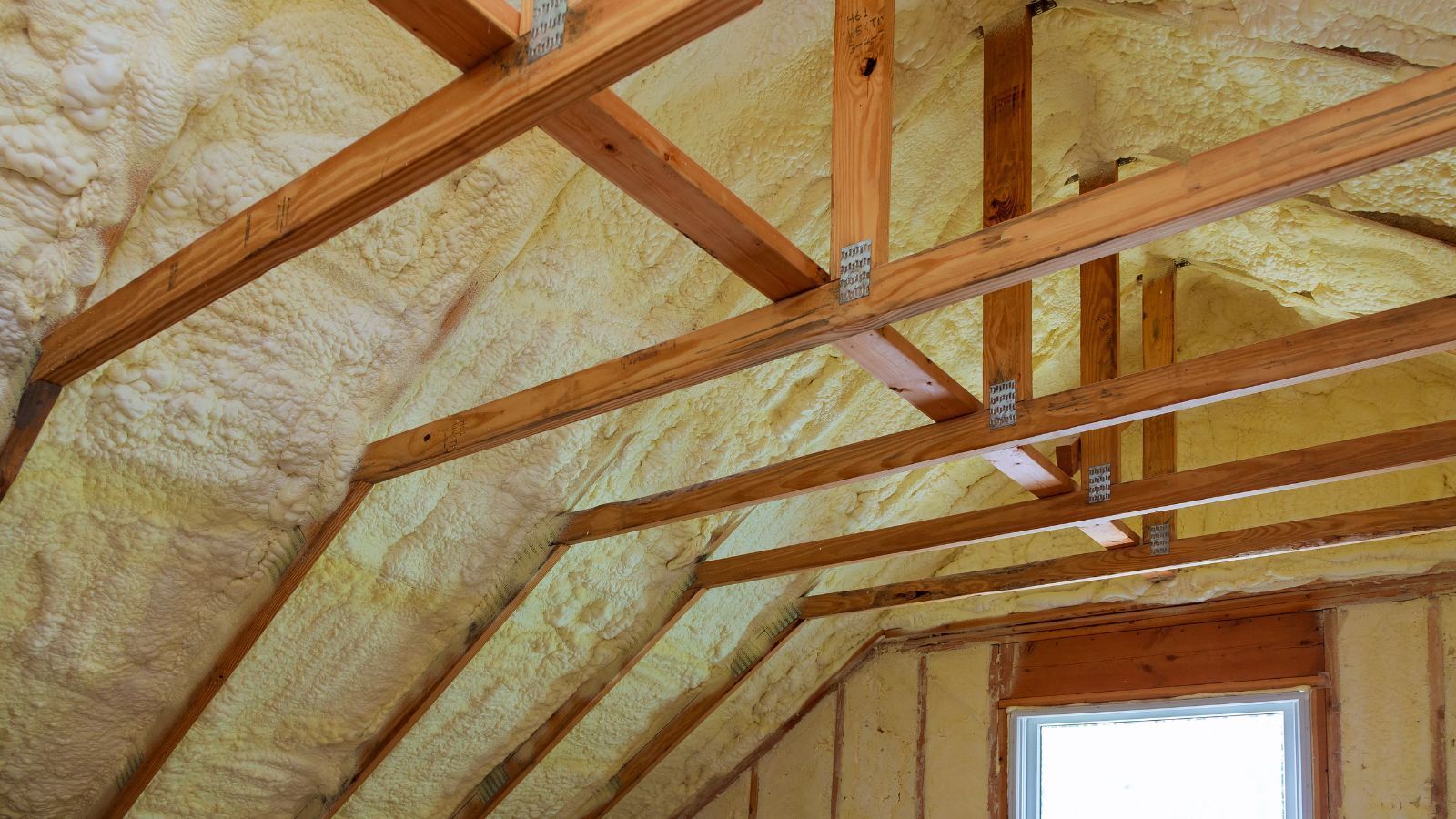
Learn how spray foam attic insulation can reduce energy bills, improve year-round comfort, and help you maintain a more eco-friendly home. When it comes to reducing heating and cooling costs, your attic insulation is one of the most impactful areas to address. Because warm air rises, a poorly insulated attic allows significant heat loss, causing your heating system to work overtime. Spray foam insulation provides an exceptional solution by creating an airtight barrier that effectively seals your attic, keeping heat inside during winter and outside in summer. This means you’ll enjoy a more comfortable home while cutting down on energy bills and carbon footprint. Improved Temperature Control Spray foam’s unique properties make it ideal for attics, especially in areas where traditional insulation materials can’t reach. As it’s applied, the foam expands to fill every gap, corner, and crevice, forming a continuous, solid layer of insulation. This means no draughts or thermal bridges, so your attic becomes a fully insulated space, adding to your home’s energy efficiency. Enhanced Indoor Air Quality In addition to energy savings, spray foam attic insulation helps improve indoor air quality. Because it forms an airtight seal, it reduces the infiltration of outdoor allergens, dust, and pollutants. Plus, unlike other insulation materials that may sag, degrade, or compress over time, spray foam retains its shape and effectiveness, providing you with long-lasting benefits. It’s suitable for both new builds and attic upgrades, making it a versatile solution for any homeowner. Maximise energy savings and comfort with high-performance spray foam attic insulation.

Discover how spray foam roof insulation shields your home from weather, lowers heating costs, and extends roof life. Your roof is more than just a cover over your head—it’s a critical component in maintaining your home’s energy efficiency and protecting it from the elements. Spray foam roof insulation provides a superior insulation solution, forming a weather-resistant barrier that helps lower heating costs and extend the life of your roof. Unlike traditional insulation, which may allow draughts and dampness to infiltrate, spray foam creates a seamless layer that effectively shields your home from the outside environment. Weather Protection and Energy Savings Spray foam insulation is particularly effective in climates like Ireland, where rain, wind, and moisture can impact home comfort and energy costs. By creating an airtight barrier under your roof, spray foam prevents warm air from escaping in winter and keeps hot air out in summer. This ensures consistent indoor temperatures, meaning your heating or cooling systems don’t need to work as hard—saving you money on energy bills. Moisture Resistance for Long-Term Roof Health Another key benefit of spray foam roof insulation is its moisture resistance. Traditional insulation materials can absorb water, leading to mould growth and degradation over time. Spray foam, however, is impermeable to water, preventing moisture build-up that could cause structural issues or unhealthy indoor air. With its added structural support, spray foam can even reinforce your roof, giving it added durability against extreme weather and daily wear and tear. For weatherproofing, energy efficiency, and lasting roof protection, spray foam insulation is the top choice.

Learn how spray foam wall insulation keeps your home cosy, reduces energy costs, and even strengthens wall integrity. Your walls play a crucial role in your home’s insulation system. When it comes to achieving optimal energy efficiency and comfort, spray foam wall insulation offers advantages that traditional methods can’t match. Spray foam adheres directly to the wall surfaces, expanding to fill gaps and crevices that other insulation might leave exposed. This ensures an airtight seal, significantly reducing heat loss and providing enhanced temperature control throughout your home. Cost Savings on Energy Bills In addition to improving comfort, spray foam wall insulation is highly effective at lowering energy costs. By preventing air from leaking in and out of walls, spray foam reduces the strain on your heating and cooling systems, allowing them to operate more efficiently and consume less energy. The result is a cosier home and lower utility bills. Added Structural Support One lesser-known benefit of spray foam wall insulation is its ability to strengthen wall integrity. The rigid nature of the foam adds a layer of support to your walls, making them more resilient against wind, vibrations, and temperature changes. Furthermore, spray foam acts as a sound barrier, reducing noise from the outside and within your home, making it a great option for urban or multi-storey properties. Upgrade your walls with spray foam insulation to enjoy lasting comfort, energy savings, and added strength.

Discover the benefits of spray foam floor insulation in preventing draughts, moisture, and heat loss in your home. Floors are often overlooked in insulation plans, but they play a significant role in maintaining indoor temperature and comfort. If you’ve noticed your floors feeling cold in winter, it’s likely due to poor insulation. Spray foam floor insulation is a highly effective solution that blocks draughts and prevents moisture infiltration, making it an excellent choice for basements, garages, and ground-level living spaces. Eliminates Cold Spots and Draughts When spray foam is applied to your floors, it forms a solid barrier that eliminates gaps and cold spots. This improves comfort by keeping your home warmer in winter and cooler in summer. Additionally, because spray foam is water-resistant, it prevents dampness from seeping through floors, protecting against mould growth and damage caused by humidity. This is especially beneficial in areas with high moisture levels, like basements or coastal homes. Energy Efficiency with Lasting Results By insulating your floors with spray foam, you can make significant improvements in both comfort and energy savings. Your heating system will have less work to do, meaning reduced energy consumption and lower heating bills. Plus, with spray foam’s long-lasting properties, you won’t have to worry about sagging or replacement over time. Transform your floors with spray foam insulation to enjoy warmth, energy efficiency, and moisture control.
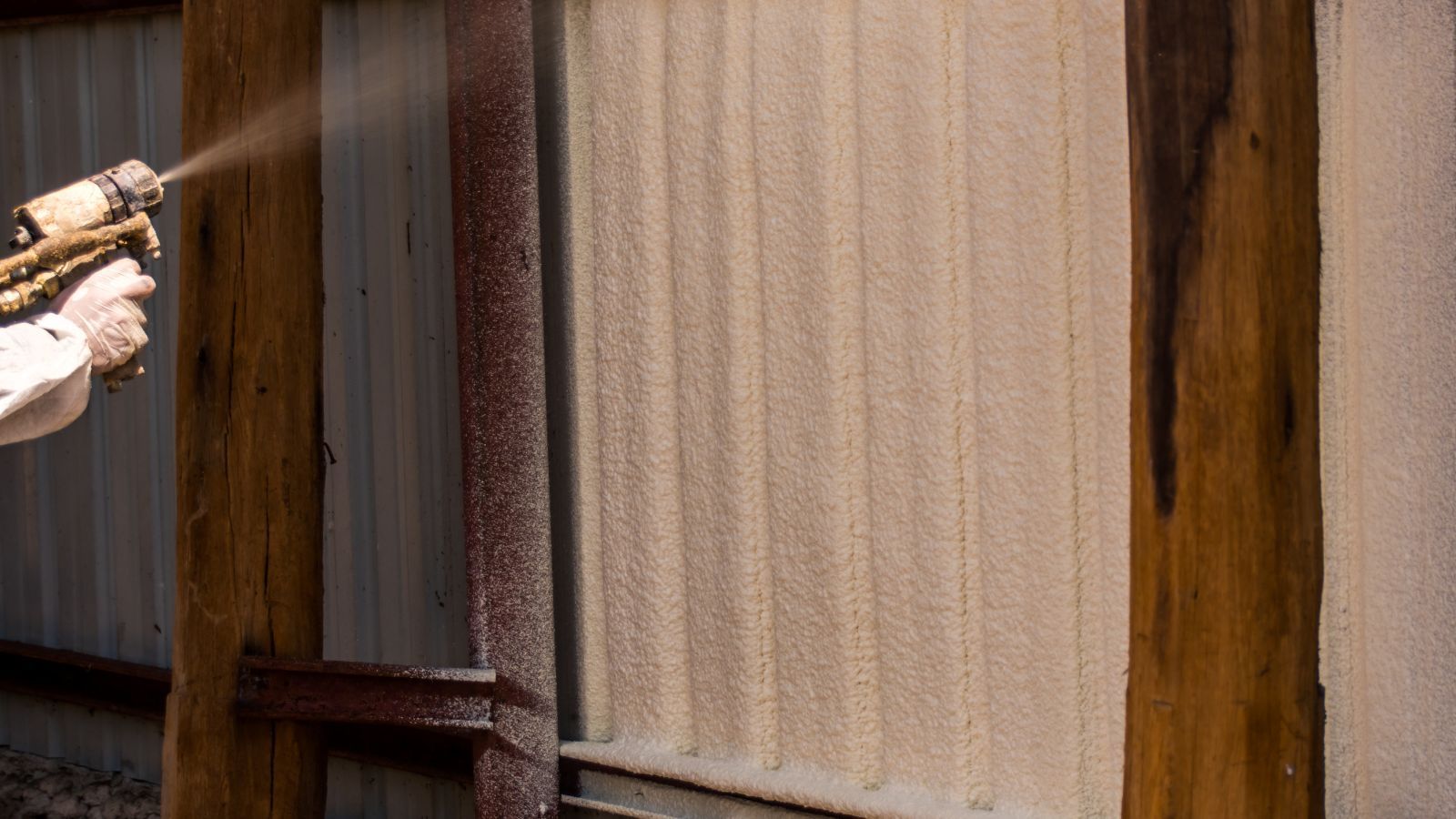
Learn how spray foam insulation can protect your shed from temperature fluctuations and moisture damage. Sheds are invaluable spaces for storage, workshops, or even relaxation. However, they’re often uninsulated and exposed to the elements, making them vulnerable to temperature changes, draughts, and moisture. Spray foam insulation offers an ideal solution by creating an airtight, weather-resistant layer that keeps sheds warm, dry, and secure all year. Protection Against Moisture Damage With spray foam insulation, your shed will be protected from the cold, damp, and humidity that can damage stored items. Spray foam prevents moisture from seeping in, which not only keeps the space dry but also reduces the likelihood of mould and mildew forming on tools, equipment, and furniture. It’s an especially valuable upgrade if your shed is used for storing items sensitive to temperature changes, like paints, electronics, or gardening supplies. Year-Round Comfort for Working or Relaxation Insulating your shed with spray foam also makes it more comfortable if you use the space for work or hobbies. The temperature control makes it possible to work in your shed year-round, without worrying about freezing temperatures or excess heat. Protect your shed and its contents with reliable, year-round spray foam insulation.

Discover how spray foam boat insulation reduces condensation and maintains a comfortable cabin temperature. Owning a boat comes with the challenge of keeping it comfortable and moisture-free, especially in cooler or humid conditions. Spray foam insulation is an excellent solution, providing temperature control and reducing condensation in the cabin. Unlike other insulation options, spray foam forms a solid barrier that prevents cold air from seeping in, allowing you to maintain a cosy cabin environment. Condensation Control for Better Health and Comfort A major benefit of spray foam boat insulation is its ability to control condensation, a common issue in marine environments. Moisture can quickly lead to mould growth, odours, and damage to interior materials, reducing the lifespan of your boat’s furnishings and equipment. By insulating your boat with spray foam, you minimise condensation buildup, creating a drier, healthier cabin that is resistant to mould and mildew. This means less cleaning and maintenance and a better overall environment for you and your passengers. Energy Efficiency and Year-Round Comfort Spray foam insulation helps regulate temperature effectively, so heating and cooling systems in your boat’s cabin work more efficiently. This is a big plus, as energy usage on a boat can often be costly or limited. With spray foam, your boat stays warmer in cooler months and cooler in summer, giving you the freedom to use your boat comfortably throughout the year. Additionally, spray foam insulation provides soundproofing, which is helpful in creating a quiet cabin space when docked or out on the water. Upgrade your boat with spray foam insulation to enjoy a dry, comfortable cabin environment on the water.

Learn how spray foam insulation turns a shipping container into a temperature-controlled, versatile space perfect for storage, offices, or even living spaces. Shipping containers have found new life as storage units, mobile offices, and even unique residential spaces. But without adequate insulation, they can be uncomfortable to use, especially during extreme temperatures. Spray foam insulation offers an ideal solution for anyone looking to convert a container into a functional, temperature-controlled environment. The foam creates a continuous barrier on the container walls and ceiling, helping to stabilise indoor temperatures, reduce condensation, and make the container suitable for year-round use. Transform Your Container into a Functional Space in Any Climate Spray foam insulation ensures that your container remains usable in both hot and cold weather by providing a high level of thermal insulation. During winter, the insulation helps retain heat, keeping the interior warm and reducing the need for portable heating. In the summer, it blocks outside heat, making it easier to keep the interior cool. This makes spray foam insulation especially valuable for shipping containers used as mobile offices or temporary housing, where comfort is a priority regardless of weather conditions. Moisture Barrier for Enhanced Durability and Protection Moisture can be a serious issue in uninsulated containers, leading to problems like rust, corrosion, and mould that can compromise the container’s structure and contents. Spray foam insulation acts as an effective moisture barrier, blocking condensation from forming on interior walls and preventing long-term moisture-related damage. This can be especially important for containers used to store valuable or sensitive equipment, documents, or materials, as it provides an additional layer of protection and peace of mind. With spray foam insulation, you can unlock the full potential of your shipping container, turning it into a comfortable, durable, and climate-controlled space perfect for a range of applications.

Discover how spray foam insulation provides reliable temperature control and moisture resistance for barns, greenhouses, and other agricultural buildings. In agriculture, maintaining the right conditions for crops, livestock, and equipment is essential for a successful operation. Temperature fluctuations and high humidity levels can negatively impact stored produce, crop yields, and even the health of livestock. Spray foam insulation offers an ideal solution for agricultural buildings, including barns, greenhouses, and storage units. This high-performance insulation provides a durable, airtight barrier that protects against temperature extremes and moisture infiltration, keeping your valuable assets safe year-round. Reliable Temperature Control for Livestock and Crops For barns and animal shelters, maintaining a consistent temperature is vital for the health and productivity of livestock. Uninsulated structures can expose animals to harsh cold in winter or excessive heat in summer, leading to stress and potential health issues. Spray foam insulation keeps barns warm in cold weather and cool in hot conditions, creating a more comfortable environment for animals and reducing reliance on costly heating or cooling systems. Similarly, greenhouses benefit greatly from spray foam insulation, as it helps stabilise temperatures and promotes healthy growth for plants and crops, leading to improved yield. Moisture Protection for Equipment and Crop Storage Spray foam insulation is not only effective for temperature control but also provides superior moisture resistance. This is especially important for agricultural buildings where crops or feed are stored, as damp conditions can lead to spoilage, mould, and mildew. By sealing gaps and preventing condensation, spray foam keeps stored goods dry and safe, reducing waste and protecting your investment. Additionally, moisture control helps preserve valuable equipment by minimising rust and corrosion, prolonging the life of machinery and tools used in daily operations. Cost-Effective and Durable Insulation for Agricultural Buildings Spray foam insulation offers long-term durability, which is especially beneficial for agricultural operations looking for cost-effective solutions. It adheres securely to various surfaces, creating a seamless and robust layer that doesn’t degrade over time like other insulation materials. Once applied, spray foam requires little maintenance, so farmers and agricultural property owners can focus on their work with confidence, knowing their buildings are well-protected. Choose spray foam insulation for a reliable, cost-effective way to safeguard your agricultural buildings, enhance livestock comfort, and protect crops and equipment from temperature and moisture challenges.
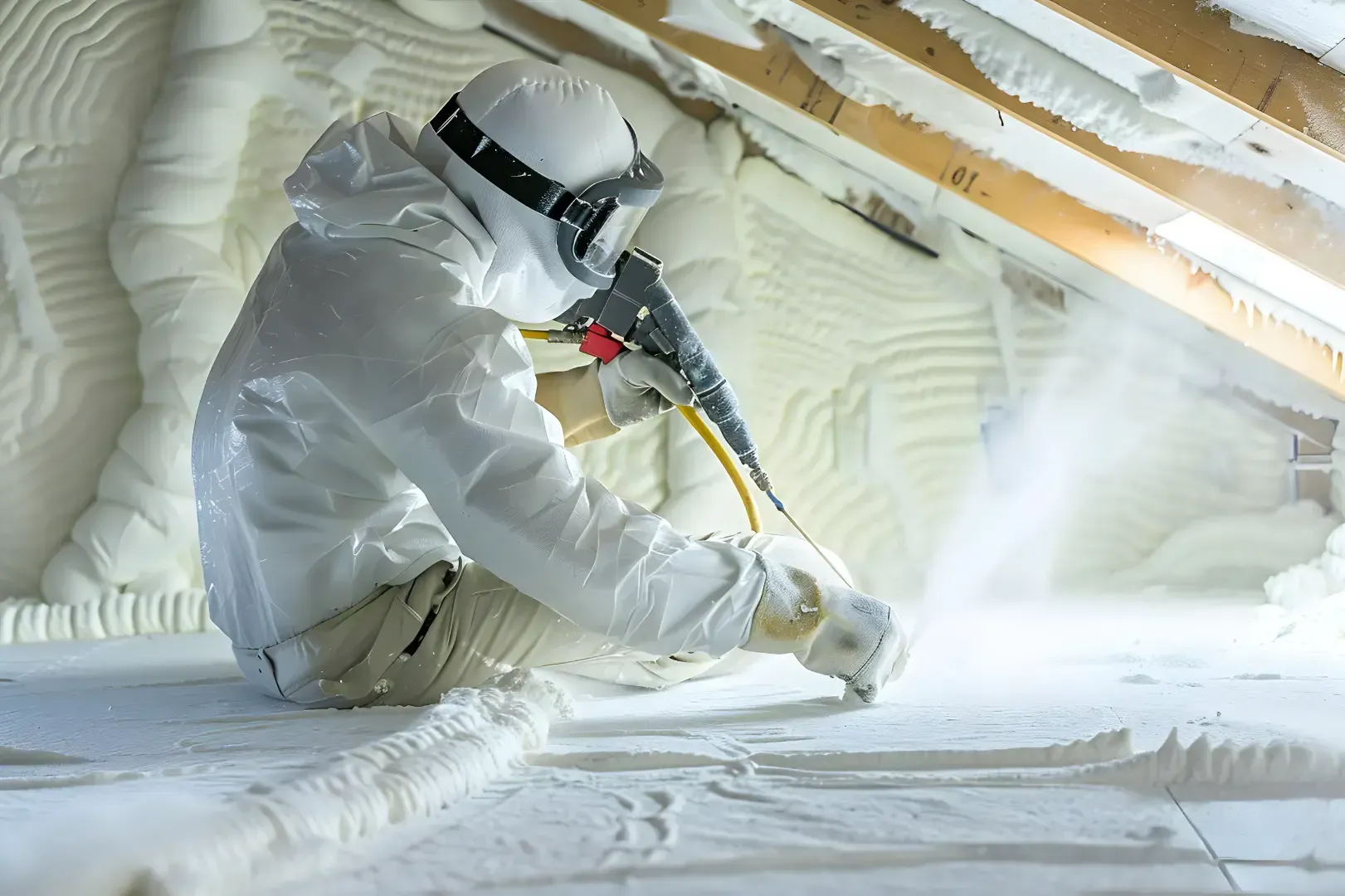
Polyurethane foam insulation is a high-performance insulation material used to improve energy efficiency, control indoor temperatures, and reduce energy costs in residential, commercial, and industrial buildings. Made from a mixture of polyols and isocyanates, polyurethane foam is applied as a liquid that expands to fill spaces, gaps, and hard-to-reach areas, creating a seamless, airtight barrier. This insulation type is known for its exceptional thermal resistance, durability, and versatility, making it ideal for diverse applications, including walls, attics, crawl spaces, and even refrigerated structures. Types of Polyurethane Foam Insulation Polyurethane foam insulation is available in two main types: Open-Cell Polyurethane Foam Open-cell foam is lighter and less dense, with an R-value (a measure of thermal resistance) typically around 3.5 per inch. This foam is permeable to water vapor, making it ideal for areas where breathability is important, like attics and walls. Open-cell foam is also highly effective for soundproofing due to its cellular structure, which can trap and dampen noise. Closed-Cell Polyurethane Foam Closed-cell foam is denser and has a higher R-value, around 6 to 7 per inch, making it one of the most effective insulators available. This foam type is water-resistant and more rigid, providing both thermal insulation and structural reinforcement. Closed-cell foam is suitable for environments exposed to high moisture or requiring additional strength, such as basements, foundations, and external walls. How Polyurethane Foam Insulation Works Polyurethane foam insulation works by expanding and filling gaps and cavities when applied, creating an airtight seal that prevents air infiltration and heat loss. It acts as a thermal barrier, effectively reducing the transfer of heat between indoor and outdoor environments. Additionally, its air-sealing qualities minimize drafts and help maintain consistent indoor temperatures, reducing the need for excessive heating or cooling. This insulation method can reduce energy costs significantly, as it stops up to 30% of the energy loss typically associated with poor insulation. With the closed-cell variant, polyurethane foam also enhances structural integrity, which can be beneficial for buildings in high-wind or earthquake-prone areas. Key Benefits of Polyurethane Foam Insulation Polyurethane foam insulation offers several advantages that make it a popular choice for property owners and builders: Exceptional Thermal Resistance: High R-value per inch means better thermal resistance, leading to greater energy savings. Air and Moisture Barrier: Prevents air leakage and moisture buildup, reducing mold risk and improving indoor air quality. Increased Structural Support: Closed-cell foam’s rigidity can reinforce walls, floors, and ceilings. Soundproofing Capabilities: Particularly with open-cell foam, polyurethane insulation provides effective sound dampening, ideal for urban or high-noise areas. Durability and Longevity: Polyurethane foam insulation is highly resistant to degradation, retaining its insulating properties for decades when properly installed. Applications of Polyurethane Foam Insulation Polyurethane foam insulation is used across various applications to suit different needs: Residential Buildings: Ideal for attics, walls, and floors, reducing energy bills while enhancing comfort. Commercial Buildings: Used in office spaces, retail establishments, and warehouses to improve energy efficiency and occupant comfort. Industrial Applications: Effective in environments requiring precise temperature control, such as food storage or chemical facilities. Agricultural Use: Protects barns, greenhouses, and storage areas, providing stable temperatures for livestock and crops. Refrigerated Structures: Closed-cell foam’s high R-value makes it suitable for refrigerated storage, keeping spaces efficiently insulated even at low temperatures. Why Choose Polyurethane Foam Insulation? Polyurethane foam insulation has become a preferred choice for many due to its unmatched performance, versatility, and durability. It helps property owners reduce energy usage and associated costs, while its water resistance and structural benefits make it suitable for challenging environments. Additionally, its ability to provide air-sealing benefits and control indoor temperature helps create healthier, more comfortable living and working spaces. As environmental consciousness grows, polyurethane foam is also being recognized for its contributions to green building standards and sustainable construction. Frequently Asked Questions 1. How long does polyurethane foam insulation last? Polyurethane foam insulation can last up to 30 years or more, depending on the environment and quality of installation. 2. Is polyurethane foam insulation safe? Yes, it’s safe when installed by professionals, as they ensure proper ventilation and application techniques to prevent off-gassing. 3. How does polyurethane foam compare to traditional insulation materials? Polyurethane foam generally offers higher R-values and better air-sealing, making it more effective for energy efficiency. 4. Can polyurethane foam insulation be used outdoors? Closed-cell foam is suitable for outdoor use as it resists water and adds strength, making it ideal for external walls and foundations. 5. Does polyurethane foam insulation prevent mold growth? Yes, its moisture-resistant properties reduce the likelihood of mold, especially in damp areas like basements. 6. Is polyurethane foam insulation eco-friendly? Polyurethane foam can contribute to eco-friendly building practices by reducing energy needs and helping buildings meet green standards. Polyurethane foam insulation offers significant benefits, from increased energy efficiency to structural reinforcement, making it a smart choice for a wide range of applications. By understanding the properties and uses of both open- and closed-cell polyurethane foams, you can make an informed decision to optimize your building’s performance and comfort.
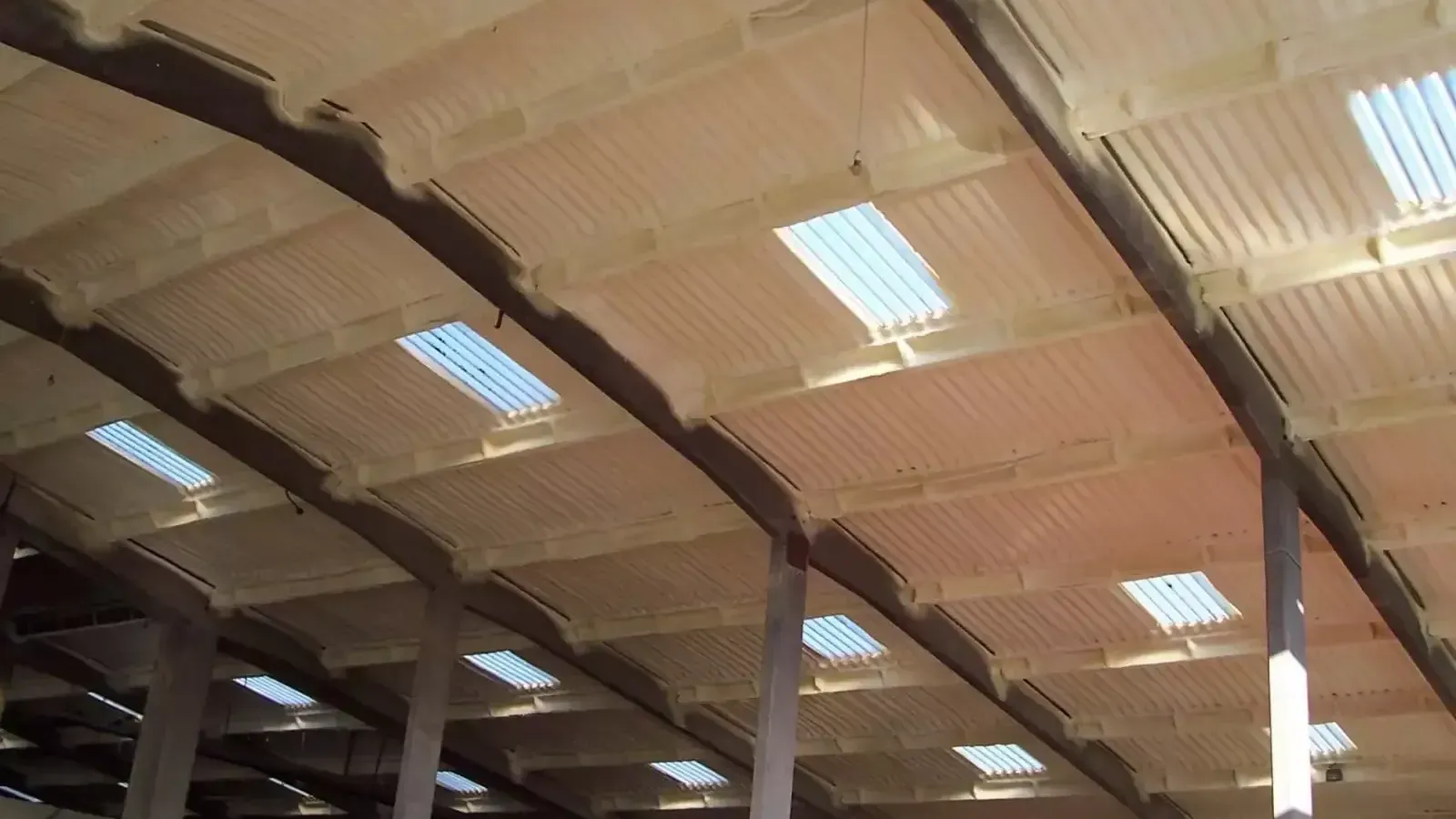
Closed cell spray foam insulation is an advanced insulation material widely used in Ireland for residential, commercial, and industrial buildings. It is highly valued for its dense structure, water-resistant properties, and exceptional insulating capabilities. Unlike open cell spray foam, closed cell spray foam forms a rigid, dense barrier upon application, making it particularly suitable for environments where both insulation and moisture resistance are required. Applied with a spray gun, it expands on contact to create an airtight, watertight seal that enhances energy efficiency and protects against moisture ingress. Key Benefits of Closed Cell Spray Foam Insulation High Insulation Value: Closed cell spray foam has one of the highest R-values per inch, meaning it provides superior insulation with less material, making it ideal for areas where space is limited. Water Resistance: The closed cell structure makes this insulation material highly resistant to water. It acts as a barrier against moisture, preventing it from seeping through walls, floors, and roofs, which makes it especially effective for environments exposed to high humidity. Structural Strength: Once applied, closed cell spray foam hardens into a dense, rigid layer. This added rigidity reinforces the building’s structural integrity, providing additional strength to walls, roofs, and other surfaces. Airtight Seal: Closed cell spray foam fills all gaps and seals them tightly, creating a continuous barrier that reduces air leakage, minimizes drafts, and maintains stable indoor temperatures. This air seal contributes to improved energy efficiency and reduced heating and cooling costs. Practical Applications of Closed Cell Spray Foam Roof Insulation: Closed cell spray foam is particularly effective in roof insulation due to its high resistance to water and its ability to add structural strength. It’s ideal for Irish roofs, which are often exposed to heavy rain and high humidity, providing both insulation and protection against moisture. Wall Insulation: The high R-value of closed cell spray foam makes it a popular choice for wall insulation in both residential and commercial buildings. It offers energy efficiency while acting as a moisture barrier, preventing issues like dampness and mould. Basement and Crawl Space Insulation: Closed cell spray foam is a great option for basements and crawl spaces due to its water-resistant properties. These areas are prone to moisture issues, and closed cell spray foam helps to create a dry, insulated environment. Exterior Applications: In addition to interior uses, closed cell spray foam is also suited for exterior insulation projects, including agricultural structures and metal buildings. It protects against external moisture while providing a strong insulating layer. Frequently Asked Questions (FAQ)
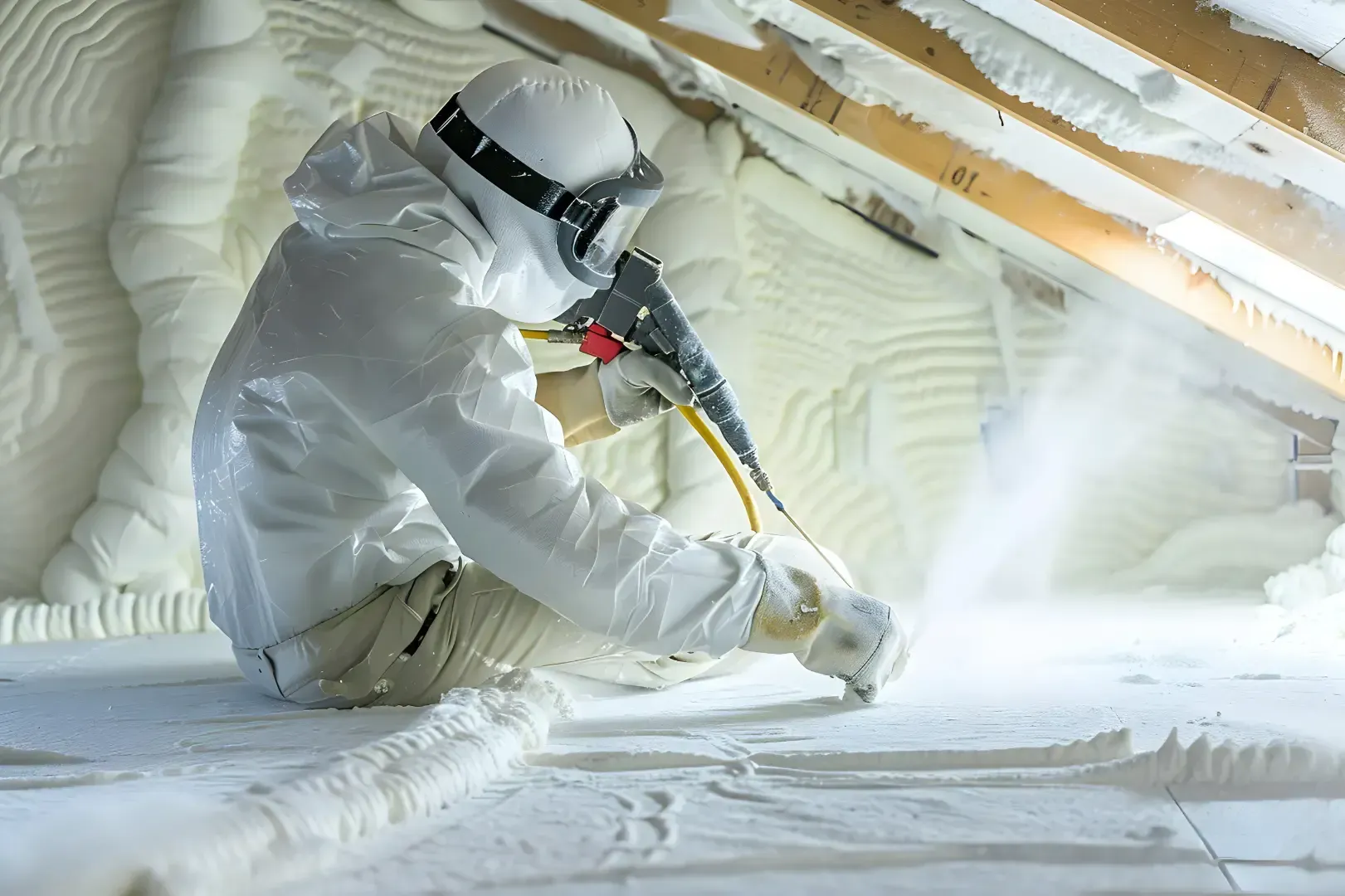
Open Cell Spray Foam Insulation is gaining popularity in Ireland as a versatile, efficient insulation material for residential and commercial properties. Known for its unique ability to expand and seal even the smallest gaps, this insulation type is highly effective for a range of applications, including attics, walls, floors, and roofs. It is applied on-site using a specialized spray gun, where the foam expands to over 200 times its original size, creating an airtight barrier that minimizes heat loss and stabilizes indoor temperatures. Key Benefits of Open Cell Spray Foam Insulation Efficient Application: Open cell spray foam can be applied quickly, even in hard-to-reach areas. Its expansion capability allows it to penetrate nooks and crannies that would otherwise remain exposed with traditional insulation methods. Breathability: One of the unique properties of open cell spray foam is its "breathability," which permits water vapour to escape from the structure. This feature helps regulate moisture, preventing the buildup of harmful mould and dampness within the walls and roof. Long-Lasting Airtight Seal: Unlike other insulation types, open cell spray foam maintains its airtight properties throughout the life of the building. This long-term performance reduces the need for future insulation upgrades, making it a cost-effective choice. Adaptable for Roofs and Attics: Open cell foam is especially popular for attic conversions. Once applied between rafters, an insulated board can be added directly to the rafters, transforming attics or lofts into comfortable, temperature-controlled living spaces. Because the foam expands to fill every gap, it creates an optimal thermal barrier, reducing heat loss and boosting Building Energy Ratings (BER). Practical Applications of Open Cell Spray Foam Attic Insulation: Attics are among the most common areas for open cell spray foam insulation. Due to its expansive properties, it easily fills every gap, providing a consistent, airtight seal that minimizes heat loss and improves energy efficiency. Wall Insulation: Internal wall insulation with open cell spray foam significantly reduces heat loss and enhances soundproofing. It’s ideal for new builds and timber frame constructions, providing both quick application and long-lasting insulation. Floor Insulation: Often overlooked, floors account for up to 15% of a home’s heat loss. Open cell spray foam can be applied beneath floorboards, efficiently filling gaps to provide a continuous thermal barrier. Roof Insulation: Insulating roofs under tiles and slates is challenging with traditional materials. However, open cell spray foam can access these hard-to-reach spaces, creating an airtight seal that enhances thermal performance. Frequently Asked Questions (FAQ)
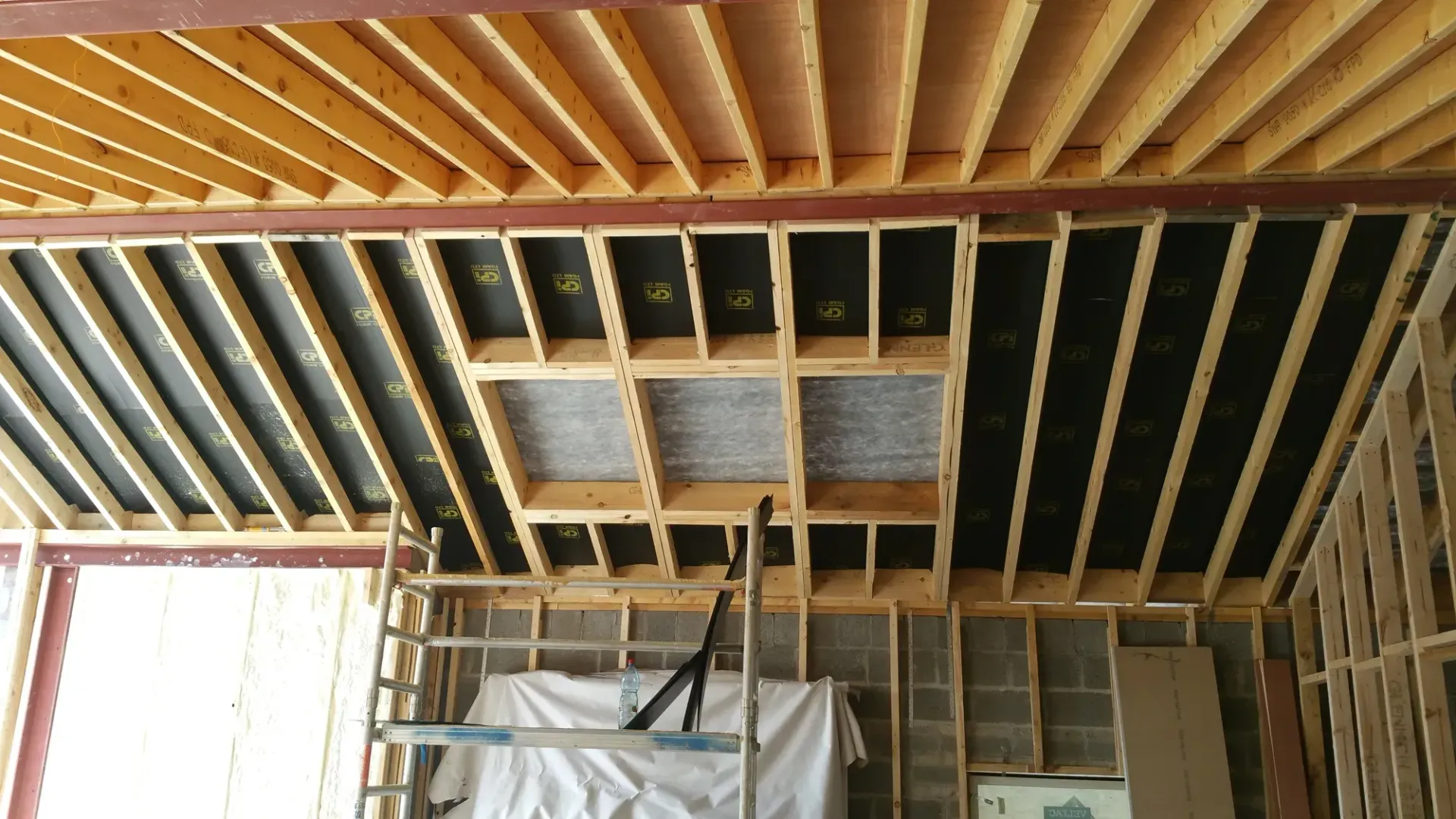
Spray foam insulation offers exceptional thermal performance and energy efficiency, but misconceptions about its impact on roof health have led to questions about its use in attics and roof spaces. One common myth is that spray foam can "suffocate" a roof, trapping moisture and leading to rot or damage. In reality, when installed correctly and combined with a breathable vent card, spray foam insulation actually enhances roof performance and protects against these potential issues. What Is a Breathable Vent Card? A breathable vent card is a pre-installation component that creates a ventilation channel between the roof deck and the spray foam insulation layer. Installed between rafters before the spray foam is applied, vent cards maintain airflow, ensuring that any moisture that may infiltrate the roofing materials has a path to escape. This prevents the accumulation of moisture and helps regulate temperature and humidity levels within the roof space. Addressing the Myths: How Breathable Vent Cards Improve Roof Health Many people worry that spray foam insulation, when applied to roofs, will trap moisture and cause rot in the wooden structures of the roof. However, a breathable vent card effectively counters this issue by allowing air to circulate, even in areas with closed-cell spray foam. Key benefits include: Moisture Control: The vent card prevents moisture from being trapped within the roof deck, allowing it to escape and reducing the risk of condensation. Enhanced Airflow: It maintains necessary airflow, which keeps the roof structure healthy and extends its lifespan. Temperature Regulation: By allowing air movement, the vent card helps regulate temperature and prevents heat buildup in the roof, which is especially important in summer. Myth-Busting: Why Spray Foam is a Safe Choice for Roof Insulation? When combined with a breathable vent card, spray foam insulation provides robust protection for roofs, without risking the structural health of the roof deck. Properly installed, it: Prevents heat loss in winter and keeps interiors cooler in summer. Reduces energy bills by creating a thermal barrier. Strengthens the overall structure of the roof, adding durability. The inclusion of a vent card ensures that spray foam remains a safe, effective, and sustainable option for roof insulation, aligning with both ventilation needs and insulation performance. If you’re considering spray foam insulation, be sure to ask about the breathable vent card option for maximum roof protection and peace of mind.


